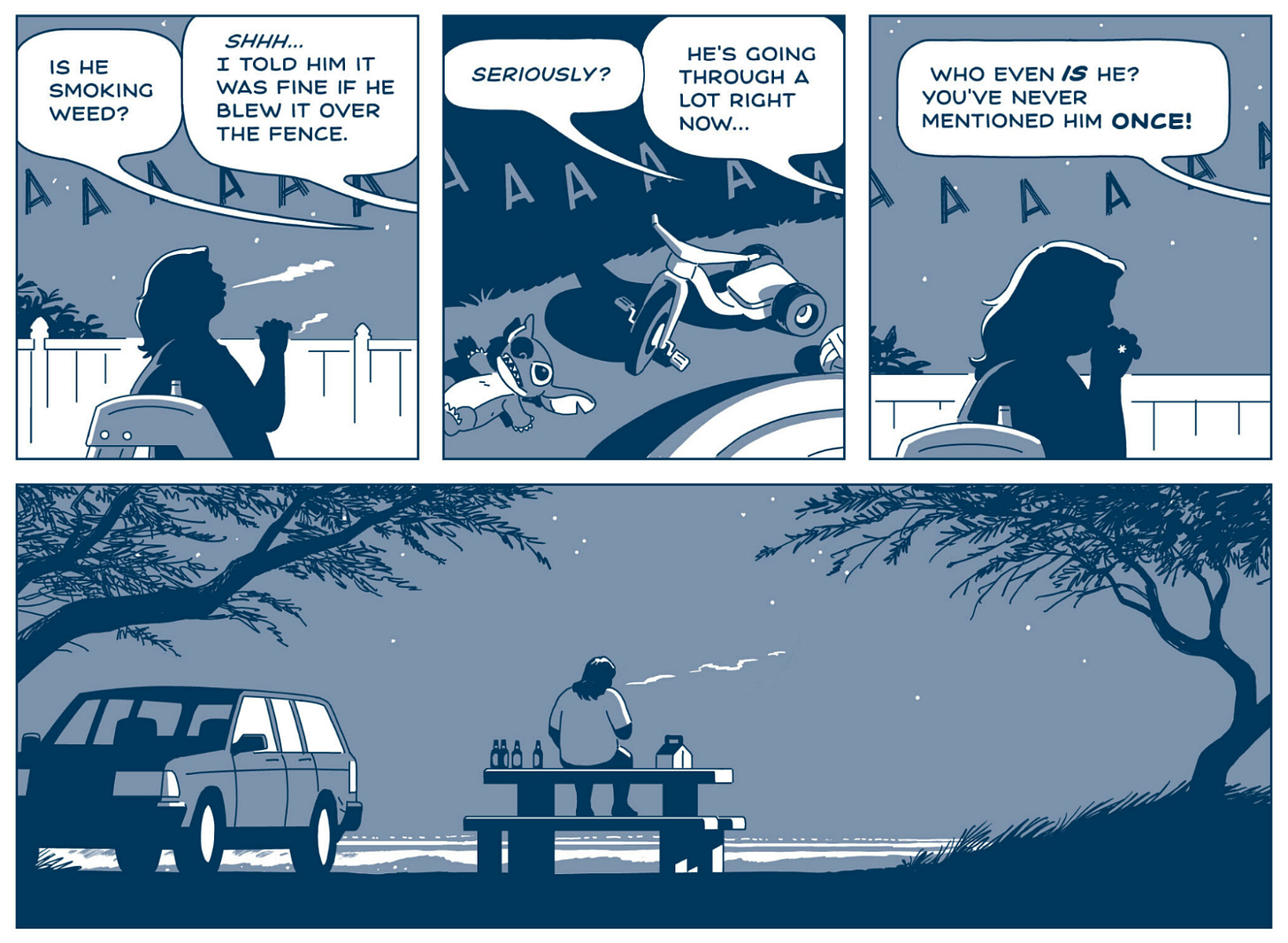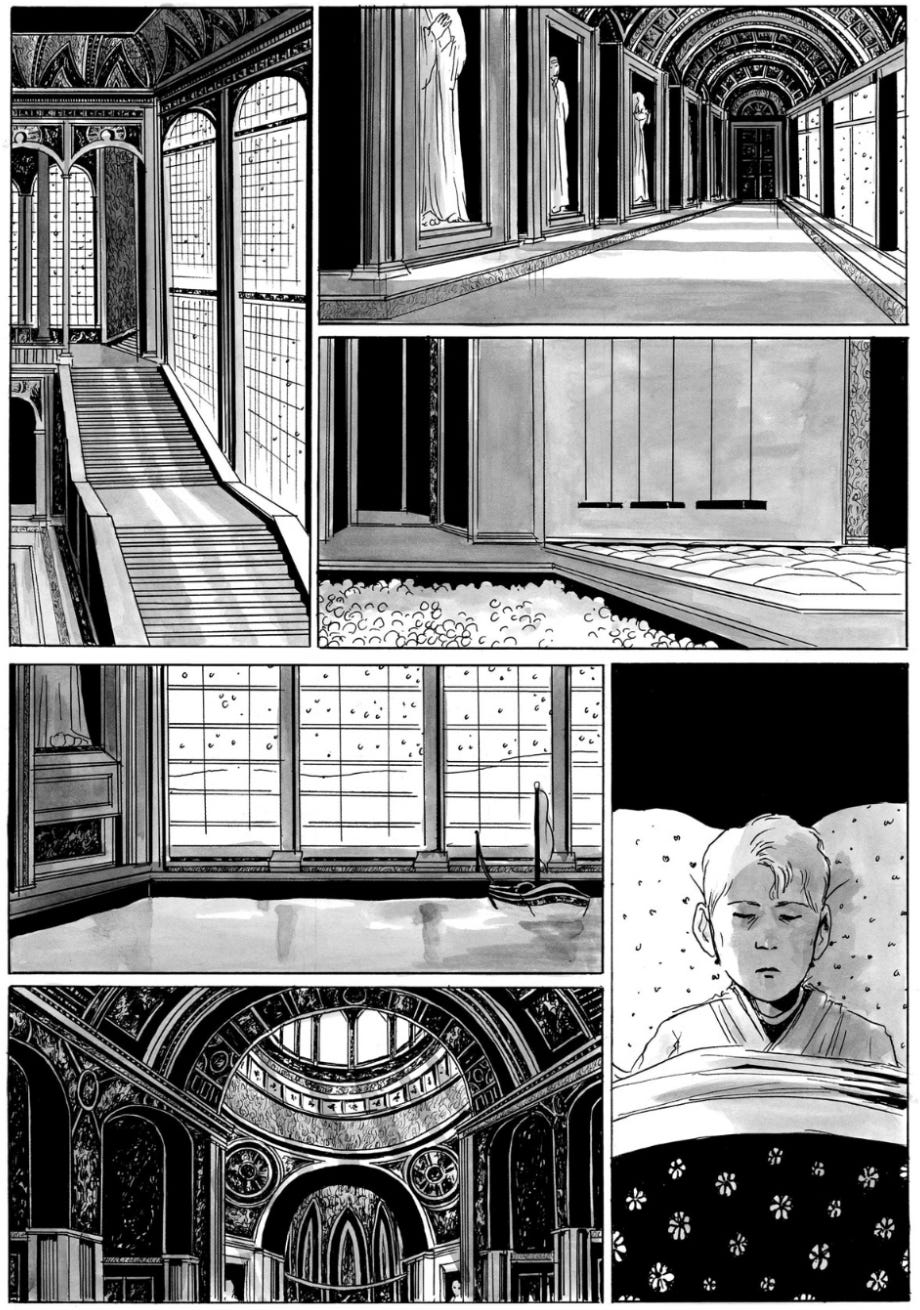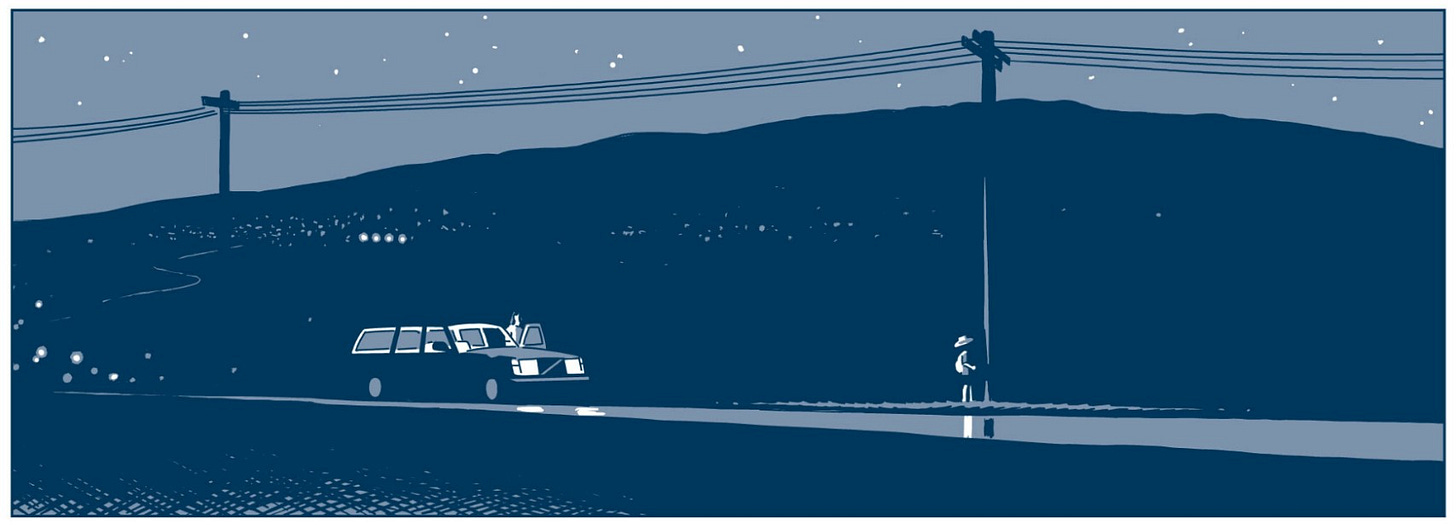How to Draw (Establishing Shots)
The significance of establishing shots in comics and mastering the art of visual economy. Plus: Wes Anderson, R. Kikuo Johnson, hex #615D68, and more.
Howdy, friend.
I’m heading back to Singapore soon, leading an education abroad trip with eleven students (most of whom have never been out of the country). Singapore is a wonderful country to amble—the public transportation is exceptional, and because of the country’s dedication to diversity, you’re likely to stumble upon some neat cultural or religious site no matter what direction you travel.
Last year in Singapore, I spent much of my free time in temples, observing and doodling. Other than the food, it’s perhaps the thing I look forward to the most; there’s something so serene about watching people come and go, listening to the wind hit the boughs of meticulously planted trees, the melodious din of street noise from over the temple walls.
So much of our life is defined by where we’re at—for instance, at this moment, writing this line, sitting at my desk in my apartment next to two great big windows overlooking downtown Lincoln, Nebraska. Characters don’t exist in a void. In prose, new writers are often guilty of employing little to no detail, making it difficult to suss out where we are. We call this White Room Syndrome. Truly, where we or our characters are in a story is of utmost importance, as it can change the mood, help underscore themes, and give us much-needed characterization.
This got me thinking about the importance of establishing shots in comics—seeing where we are spatially—and that while we don’t need to see the detail of every room a character is in, we must understand where they are physically for us to connect to them. We talk about establishing shots in film, but I don’t see it mentioned enough regarding comics, even though they are essential to this form of storytelling. So, in this month’s newsletter, I thought it would be fun to explore what establishing shots are, look at some examples, and understand their importance.
If this is your first time visiting How to Draw, a hearty welcome. You can check out our archive of posts here. And if you haven’t already, please consider subscribing so you don’t miss a thing.
Take care of yourself, friend. ♡
– RJR
As I’m fond of articulating, comicsmaking and filmmaking are analogous in some fun ways. While comics are static and films are not, how we frame panels/shots, the use of diegetic space (where characters live and act), and color palettes are a small sampling of how these art forms intersect.
So, what is an establishing shot?
A scene that shows a spatial relationship between its important figures, objects, and locations, often revealing important context.
You may not even be aware of these shots in most films you watch, and all the heavy lifting they do. While the location is important, these shots also set the tone. If two characters are breaking up in a crowded living room, versus a bustling coffee shop in a run-down Midwest town, we get very different emotional outcomes. Is your location endlessly rainy (think of Seven)? Or, does your use of colors help establish playfulness from the get-go, a la Wes Anderson? Establishing shots are coded to help us understand what’s to come.
Take, for example, this shot in Anderson’s The Grand Budapest Hotel:
While this film has some darker, more “adult” themes, it’s still rife with Anderson’s unique whimsical charm. The colors tell us we’re going to have some fun, and the rather busy shot (lots of bodies moving about) sets this up as a kinetic film while the titular hotel remains steadfast, a place we will keep coming back to.
Let’s look at another example, Sergio Leone’s The Good, the Bad, and the Ugly. Here, the opening uses two establishing shots in quick succession:
What do we see? A serious man taking up the full shot: a bounty hunter. Then: A dusty, forgotten town. After these two shots play out, two additional men arrive on the horizon, and the three attempt to take into custody Eli Wallach’s Tuco, a dangerous man with a bounty on his head. These establishing shots relay a certain desperation to be here, in this place, presumably at the end of the world where only the strongest survive and away from a “civilized” society. A desperation to be here looking for the money Tuco’s bounty will bring in.
Let’s look at one more from Joon-ho Bong's Parasite:
This shot lingers on the socks before eventually panning to show us the cramped, hovel-like home of the Kim family. From our vantage, we can see they live below ground in the basement of some building. Outside, the world bustles by. This family is unseen—a major theme of the film—and this shot helps reinforce this idea. The use of color here is magnificent as well: the dull grays and browns of the interior of their apartment are contrasted with the pops of color outside (the green of the vending machine, the blue of the trashbags, the latter indicating this family is beneath even refuse in this society).
Again, without the viewer even realizing it, establishing shots do a lot of heavy narrative lifting. The same can be said for comics, although we also have to understand an additional concept, visual economy—that each panel must communicate the necessary information without overwhelming the reader with unnecessary details. Namely, it’s about choosing which details to include to guide the reader's focus.
So, we use varying levels of detail to create moments of tension, suspense, or quiet reflection, contributing to the overall mood of the story. By controlling the flow of information through visual storytelling, creators can manipulate the reader's sense of time and create dynamic narrative rhythms.
The tl;dr of it:
In film, details of place usually always matter; we can’t escape the mise-en-scène, the production, the sets, the physicality.
Comics often lean into the metaphorical. Establishing details is necessary, but we can edit these down while still being emotionally effective. This is why you can have panels with characters talking and zero background detail without it being distracting.
Take, for instance, this panel from Craig Thompson’s Blankets:
Blankets is an autobio graphic novel about Thompson growing up in an Evangelical Christian family. His relationship with his brother is crucial to the narrative, so this establishing shot gives us a sense of how cramped their room was, the bed they shared. How intertwined their life was.
But after this page, we get panels like this, all background elements removed:
What can we infer? They shared a tiny life and yet the two of them, in that bed, was enough—together they had everything they needed. A beautiful sentiment that works with the background details removed—which itself only works after an establishing shot gives us insight into their physical context.
Another example, this sequence of panels from Zoe Thorogood’s It's Lonely At The Centre Of The Earth:
This book, another autobio, deals with Thorogood’s struggles with mental health and relationships and finishing a major illustrative project. This first panel, an establishing shot showing her desk, is followed by a detached, absurdly drawn portrait of her drinking booze/poison/whatever, and we end up seeing her inability to draw. That middle panel—an extratemporal rendition of Thorogood removed from the narrative—helps heighten the anxiety, but again only works because we see it sandwiched between the clutter of the desk and the blank white page of her notebook (again: anxiety-inducing, all of it).
Here are a few more examples. How do the establishing shots make you feel—is it easy to understand what they're trying to do?
In R. Kikuo Johnson’s No One Else, chaos gives way to a calmer establishing shot, a breath for the character (and us, too).
In Sammy Harkham’s Blood of the Virgin, another moment of solace between a bickering couple allows us some breath and reminds us of their shared space.
And in Tillie Walden’s fantastical The End of Summer, the emptiness of a palace besieged by a formidable winter storm portends a deep, noxious isolation.
While working on my forthcoming memoir Hard Body, I use establishing shots in various ways. Here, paired with some narrative text, to set the tone of my life living in Oxford, England, far away from everyone and everything I’ve known.
Here, to help to set the tone of my despair and isolation.
And here, a single image spread across three panels highlighting how asynchronous and invisible I felt living in Los Angeles.
Establishing shots are instrumental in pulling our gaze onto the page and into the narrative. In comics, every panel counts; we are the directors, and establishing context for our worlds gives us a sense of freedom to explore outside of our—and our reader’s—expectations.
What I’m reading:
Novel: Like Happiness by Ursula Villarreal-Moura
Memoir: Devout by Anna Gazmarian
Poetry: The Far Field by Theodore Roethke
Graphic: No One Else by R. Kikuo Johnson
Graphic: Rolling Blackouts by Sarah Glidden
Graphic: Disquiet by Noah Van Sciver
Graphic: “The Joy of Nail Polish” by Joy Alicia Raines (The Offing)
Graphic: “The Diary of a Rikers Island Library Worker” by Medar de la Cruz (The New Yorker)
A perfect panel:
No One Else by R. Kikuo Johnson
The color I’m obsessed with right now:
hex #615D68 – “Scarpa Flow”
News:
Mark your calendars! I’ll be leading another Free Friday Comics Workshop for the Sequential Artists Workshop (SAW) on Friday, June 28 at 7:00 PM Eastern. These workshops are FREE to register for (you can also stream live on YouTube). More details on my theme as we get closer, but hope to see you there!
I’m thrilled to announce that I was selected to be a Comics Editor Fellow with Shenandoah Literary. In 2025, I’ll be joining the editorial team and curating comics for a forthcoming issue. It’s a ways off, I know, but if you’re looking to finish some illustrative work between now and then, I’d love to see your submission!






















Love the comparison between film and graphic novels here—that framing of narrative happening in each with both what is and is not present in a composed visual.
Congratulations on your wonderful work and way of sharing visual experiences. Thank you so much!